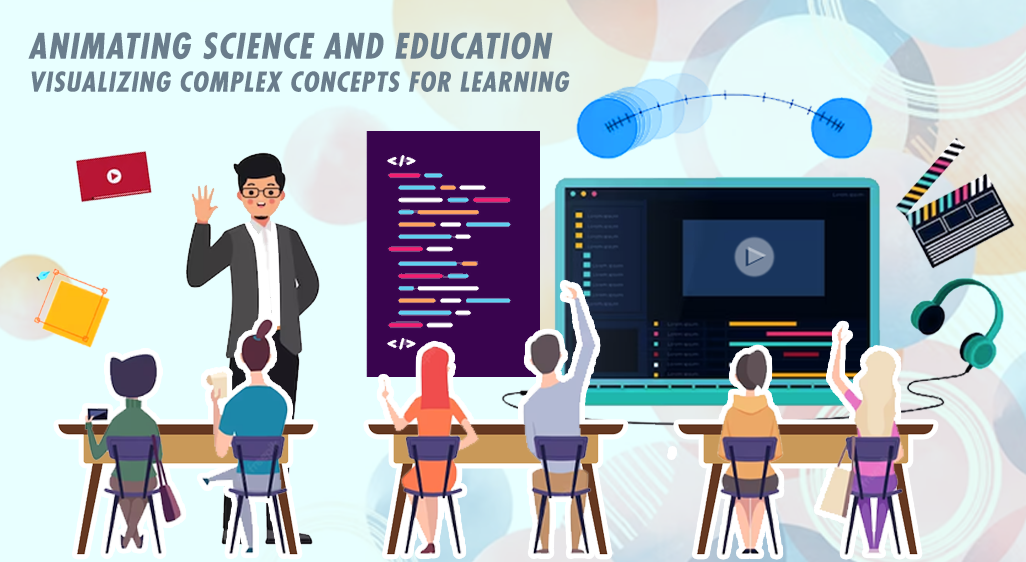It might be difficult to explain complicated scientific ideas in the context of education. Students frequently find it challenging to properly understand concepts in several areas due to their abstract character. However, with the introduction of animation, educators have found a potent tool to increase the effectiveness and engagement of learning. Complex scientific ideas can be simplified, represented, and brought to life through the art of animation in ways that capture students’ attention. This blog will examine the amazing potential of animation in science and education and how it is transforming the educational process for students all around the world.
The Power of Visual Learning
The saying “a picture is worth a thousand words” holds in the world of education. Visual learning has been shown to enhance comprehension and retention of information. When students can see and interact with concepts, they are more likely to understand and remember them. Animation takes visual learning to the next level by providing dynamic, interactive, and memorable experiences that can leave a lasting impact on young minds.
Overcoming the Challenge of Complexity
Science, in particular, is often filled with intricate concepts and abstract theories. Attempting to explain these ideas through traditional methods, such as lectures or textbooks, can be overwhelming for students. Animation serves as a bridge between the abstract and the concrete, breaking down complex concepts into digestible visual representations. Through animation, educators can create vivid explanations that simplify challenging topics, making them more accessible to learners of all ages.
Making Learning Fun
One of the most significant advantages of using animation in education is that it makes learning fun. When students are engaged and entertained, they are more likely to participate actively in the learning process. Animation can turn scientific concepts into exciting adventures, taking students on journeys through the human body, into outer space, or even back in time. By turning learning into a captivating experience, animation sparks curiosity and a thirst for knowledge among students.
Real-World Applications
Animation’s potential extends beyond traditional classroom settings. It is especially valuable in distance learning and e-learning platforms, where educators can use it to create interactive virtual lessons that students can access at their convenience. Additionally, animation allows for the visual representation of scientific phenomena that are otherwise impossible to observe directly, such as subatomic particles or the formation of galaxies. This visualization helps students grasp concepts that would otherwise remain abstract.
Enhancing Retention and Recall
Studies have shown that learners retain information better when it is presented in a visually appealing and engaging manner. Animation stimulates multiple senses and emotions, reinforcing the learning process. Students can visualize processes step-by-step, understand cause-and-effect relationships, and recall information with greater ease. Animation’s ability to create vivid mental images aids long-term memory retention, ensuring that knowledge stays with students well beyond exams and assessments.
Fostering Creativity and Critical Thinking
Animation is not just a tool for presenting information; it is an art form that encourages creativity and critical thinking. When students are exposed to animated visuals, they are inspired to think creatively and imagine various possibilities. In science, this can lead to innovative problem-solving and a deeper understanding of the subject matter. Animation sparks curiosity and motivates students to explore and question the world around them.
Applications in Various Science Disciplines
Biology
In biology, animation can bring cellular processes, DNA replication, and human anatomy to life. It allows students to witness the inner workings of cells, the complexities of the human body, and the interactions between organisms in their natural habitats.
Physics
Physics can be a daunting subject, especially when dealing with abstract concepts like relativity or quantum mechanics. Animation simplifies these topics, illustrating principles of motion, energy transfer, and the behavior of particles.
Chemistry
Chemistry involves understanding the behavior of atoms and molecules, which can be challenging without visual aid. Animation helps students visualize chemical reactions, molecular structures, and the periodic table.
Earth Science
Animation is ideal for illustrating geological processes, weather patterns, and the movements of tectonic plates. It allows students to observe natural phenomena that occur over extended periods.
Astronomy
Animation is particularly effective in astronomy, where it can visualize celestial movements, planetary orbits, and cosmic events like eclipses and supernovae.
Bridging Language and Cultural Barriers
Animation is a great tool in a variety of educational contexts since it transcends linguistic and cultural boundaries. Complex topics can be understood by students from a variety of linguistic backgrounds without the requirement for substantial translation or language proficiency. Additionally, animation may be modified to appeal to pupils from various cultural backgrounds, resulting in an educational experience that is open to all.
The Future of Animated Education
The capabilities of educational animation will develop along with technology. With the development of virtual reality (VR) and Augmented Reality (AR), there are more options than ever for immersive, interactive learning. With the aid of these technologies, students can enter virtual worlds, engage with scientific phenomena, and carry out experiments without any danger.
Animation has emerged as a powerful tool in science and education, transforming the way students learn complex concepts. By harnessing the captivating nature of animation, educators can break down barriers to comprehension, make learning more enjoyable, and foster creativity and critical thinking. With the advent of new technologies and ever-evolving animation techniques, the future of animated education holds boundless possibilities for enhancing the learning journey.
As we continue to explore the potential of animation in science and education, it becomes clear that this dynamic medium has the power to unlock young minds and ignite a passion for learning that will last a lifetime. By embracing the art of animation, educators can create an enriching and transformative learning experience that prepares students to become the scientists, innovators, and problem-solvers of tomorrow.












